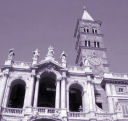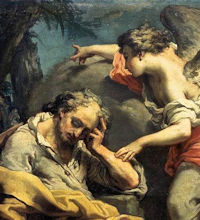» Enjoy our Liturgical Seasons series of e-books!
This year (2023) Advent is very short with Sunday being the only day in the fourth week. In the General Roman Calendar, today is the last day of Advent, Christmas Eve, and also (beginning with the vigil Mass) is the first day of Christmas time. The liturgical texts express wholehearted confidence in the imminent coming of the Redeemer. There is much joyous expectation. Most families have their own observances, customs that should be preserved from generation to generation. Today is the last day of our Christmas Novena.
Station Church Information >>>
For those following the Jesse Tree, you can either continue through Christmas Eve following Catholic Culture's Jesse Tree, or use symbols based on the “O” Antiphons (see Jesse Tree Instructions and O Antiphons).
Commentary on the Mass Readings for the Fourth Sunday of Advent, Cycle B:
The Second Reading is from the Letter of St. Paul to the Romans 16:25-27, where he introduces himself to the Christians in Rome and he gives an incomplete synthesis of his theology. His words remind us to give glory to God this Christmas and always, for the marvelous things he has done for us.
The Gospel is from Luke 1:26-38. At the moment our Lady said: "be it done to me according to thy word" the most stupendous event that ever happened, or ever could happen on earth, took place on this planet of ours. The Son of God took on human nature in the womb of the Blessed Virgin. We are familiar with this story from childhood. We often say the Angelus in which this tremendous act of God's love is described. Although familiarity, in this case, does not breed contempt, it does help to blunt the real impact on our minds of such an extraordinary occurrence. If God had created a very special child, and made him into an outstanding saint, so that he could intercede with God for us, this would be a great act of love for us on God's part. Or, if he had sent an angel from heaven in human form, to teach us all about God and to help us to lead holy lives, this would deserve our deepest gratitude. But neither a saintly man nor a holy angel could do for us all that God wanted. No man or angel could make us adopted sons of God and heirs of heaven. It was necessary, in God's plan for us, that his divine Son should become man, should share our humanity so that we could share his divinity.
Could infinite love have gone any further? Our creation, the fact that we exist as human beings on earth, is a great gift to us on the part of God. Of what value could eighty, a hundred, even seven hundred years of a continuously happy life on this earth be for us if we learned that we had to depart life forever one day? In a world tormented by sin and its evil effects our normal span of life would be less satisfying. However, when God created us, he so planned that our stay here would be but a stage, a stepping stone in fact, toward our everlasting home. We are well aware indeed of the lengths to which God's love has gone in order to make us his children and heirs to his kingdom. Are we, however, grateful to him for the love he has shown us? Are we honestly and sincerely trying to make ourselves worthy of the great future he has in store for us?
Today is a suitable occasion to look right into our hearts, to see how we stand with God. During the week we shall be keeping the feast of Christmas. The Baby in the manger will remind us of what God has done and is still doing for us. What are we doing in return? Have we shown our gratitude by living as true followers of Christ? If most of us must answer: "no," this is the time to change our course and return to the right road once more. God is asking this of us today. Shall our answer be: "behold here I am Lord, your humble and grateful servant, let it be done to me according to your word"?
Fourth Sunday of Advent For more on Santi Dodici Apostoli, see: For further information on the Station Churches, see The Stational Church. Christmas Eve at Church
The certitude of His coming is made clear in two images. The first is that of the closed gate of paradise. Since our first parents were cast forth from the earthly paradise the gate has been closed and a cherubim stands guard with flaming sword. The Redeemer alone is able to open this door and enter in. On Christmas Eve we stand before the gate of paradise, and it is for this reason that Psalm 23 is the theme of the vigil: Lift up your gates, O princes, Christmas Eve at Home
Christmas Eve is an appropriate time for the exchange of gifts, after the Christ-Child has been placed in the manger, and the special prayers before the crib — and a round of Christmas carols — are over. If the gifts are given out before the Midnight Mass, the children can concentrate more easily on the great mystery which is celebrated, when the Greatest Gift is given to all alike, even those who have received no material expression of Christmas love. And then, too, Christmas Day with its two additional Masses can be devoted more to the contemplation of the Christmas mystery and the demands of Christmas hospitality.
Vigil Mass, Christmas Eve For more on Santa Maria Maggiore, see: For further information on the Station Churches, see The Stational Church. Advent Reflection: The Light of a New Humanity
In his portrayal of the life of St. Nicholas, his most ancient biographer, a certain Archimandrite Michael, says that Nicholas received is dignity from Christ's own sublime nature just as the morning star receives its brilliance from the rising sun. Nicholas was a living imitation of Christ: "In the radiance of his virtues", says the biographer, "the sun's righteousness has dawned." Tradition has always equated Santa Claus with the Bishop Nicholas who participated in the Council of Nicaea and, together with that first great assembly of bishops, helped to formulate the affirmation of the true divinity of Jesus Christ. What was at stake here was the core of Christianity, whether Christianity was to become just another sect or something really new, faith in the Incarnation of God himself. Was Jesus of Nazareth only a great religious man, or had God himself actually become, in him, one of us? So, ultimately, the question was this: Is God so mighty that he can make himself small; is he so mighty that he can love us and really enter our lives? For if God is too far away from us to love us effectively, then human love too is only an empty promise. If God cannot love, how can man be expected to do so? In professing faith in God's Incarnation, therefore, it was ultimately a case of affirming also man's capacity to live and die in a human manner. The figure of St. Nicholas, Santa Claus, illustrates and symbolizes this connection. Theodor Schnitzler put this very well: "In putting his signature, in faith, to the mysterium of the incarnate Son of God, a person is enabled to be a helper of his fellow men, to bring happiness to children, families and the oppressed. Faith in the Incarnation promotes the salvation of mankind and the implementation of human rights." The oldest sources concerning St. Nicholas also point in the same direction from a different angle: Nicholas is one of the first people of to be venerated as a saint without having been a martyr. During the persecution of Christians, those who opposed the pagan state power and gave their lives for their faith had quite automatically become great examples of faith. When peace was concluded between Church and state, people needed new models. Nicholas impressed them as one ready to help others. His miracle was not that of great heroism in the face of torture, imprisonment and death. It was the miracle of constant kindness in everyday life. Another of the legends expresses it very beautifully in this way: Whereas all the other miracles could be performed by magicians and demons, and thus were ambivalent, one miracle was absolutely transparent and could not involve any deception, namely, that of living out the faith in everyday life for an entire lifetime and maintaining charity. People in the fourth century experienced this miracle in the life of Nicholas, and all the miracle stories which accrued subsequently to the legend are only variations on this one, fundamental miracle, which Nicholas' contemporaries compared, with wonder and gratitude, to the morning star reflecting the radiance of the light of Christ. In this man they understood what faith in God's Incarnation means; in him the dogma of Nicaea had been translated into tangible terms. The morning star which receives its light from the rising sun—this ancient description of St. Nicholas is also one of the oldest images of the meaning of Advent. If we are to be continually lighting candles of humanity, giving hope and joy to a dark world, we can only do so by lighting them from the light of God incarnate. This, at the deepest level, is the message of all Santa Claus figures: from the light of Christ we are to light the flame of a new humanity, caring for the persecuted, the poor, the little ones—this is the core of the legend of St. Nicholas.
Fourth Sunday of Advent
At Rome, the Station is in the Basilica of the Twelve Apostles, better known in Rome as better known as Santi Apostoli. We receive today a twelve-fold blessing from the apostles with whom we celebrate this last Sunday of Advent. As living stones we are built on these twelve solid and sacred foundation stones who themselves rest on the divine cornerstone, Christ. Ye holy apostles of Christ, be with us and pray for us, that with well-prepared hearts we may "go forth to meet Him, and say: Great is His dominion, and His kingdom will have no end; He is God, the Mighty, the Ruler, the Prince of Peace." For more on Santi Dodici Apostoli, see: For further information on the Station Churches, see The Stational Church.![]() Jesse Tree, Day 22 ~ St. John the Baptist
Jesse Tree, Day 22 ~ St. John the Baptist
Jesse Tree Overview
The First Reading is taken from the Second Book of Samuel 7:1-5; 8-11, 16, and refers to when David was anointed king in Hebron by all the tribes of Israel and Judah and his first step was to capture Jerusalem from the Jebusites and make it the political capital of his kingdom.
—Excerpted from The Sunday Readings by Fr. Kevin O'Sullivan, O.F.M.

Station with Ss. XII Apostoli or Santi Dodici Apostoli (Church of the Twelve Holy Apostles):
At Rome, the Station is in the Basilica of the Twelve Apostles, better known in Rome as better known as Santi Apostoli. We receive today a twelve-fold blessing from the apostles with whom we celebrate this last Sunday of Advent. As living stones we are built on these twelve solid and sacred foundation stones who themselves rest on the divine cornerstone, Christ. Ye holy apostles of Christ, be with us and pray for us, that with well-prepared hearts we may "go forth to meet Him, and say: Great is His dominion, and His kingdom will have no end; He is God, the Mighty, the Ruler, the Prince of Peace."
![]()
 The entire liturgy of Christmas Eve is consecrated to the anticipation of the certain and sure arrival of the Savior: "Today you shall know that the Lord shall come and tomorrow you shall see His glory" (Invitatory of Matins for the Vigil of the Nativity). Throughout Advent we have seen how the preparation for Jesus' coming became more and more precise. Isaiah, John the Baptist and the Virgin Mother appeared throughout the season announcing and foretelling the coming of the King. We learn today that Christ according to His human nature is born at Bethlehem of the House of David of the Virgin Mary, and that according to His divine nature He is conceived of the Spirit of holiness, the Son of God and the Second Person of the Trinity.
The entire liturgy of Christmas Eve is consecrated to the anticipation of the certain and sure arrival of the Savior: "Today you shall know that the Lord shall come and tomorrow you shall see His glory" (Invitatory of Matins for the Vigil of the Nativity). Throughout Advent we have seen how the preparation for Jesus' coming became more and more precise. Isaiah, John the Baptist and the Virgin Mother appeared throughout the season announcing and foretelling the coming of the King. We learn today that Christ according to His human nature is born at Bethlehem of the House of David of the Virgin Mary, and that according to His divine nature He is conceived of the Spirit of holiness, the Son of God and the Second Person of the Trinity.
Open wide, eternal gates,
That the King of Glory may enter in. . . .![]()
 It must be so that the grown-ups may devote themselves with a quiet mind, unhindered by any commotion, to these great mysteries of the Holy Night, that in most Catholic countries the giving of gifts has been advanced to Christmas Eve.
It must be so that the grown-ups may devote themselves with a quiet mind, unhindered by any commotion, to these great mysteries of the Holy Night, that in most Catholic countries the giving of gifts has been advanced to Christmas Eve.
 The opening of the eternal gates through which the King of Glory may enter is indicated by the wreath on the door of our homes at Christmastide. The Advent wreath, which accompanied the family throughout the season of preparation may be taken down. The violet ribbons are removed, and it is gloriously decorated with white and gold. It is then placed upon the door as a symbol of the welcome of Christ into our city, our home and our hearts. On Christmas Eve the whole house should be strewn with garlands and made ready for the Light of the World. The crib is set in a special place of honor, for tonight the central figure of the Nativity scene is to arrive.
The opening of the eternal gates through which the King of Glory may enter is indicated by the wreath on the door of our homes at Christmastide. The Advent wreath, which accompanied the family throughout the season of preparation may be taken down. The violet ribbons are removed, and it is gloriously decorated with white and gold. It is then placed upon the door as a symbol of the welcome of Christ into our city, our home and our hearts. On Christmas Eve the whole house should be strewn with garlands and made ready for the Light of the World. The crib is set in a special place of honor, for tonight the central figure of the Nativity scene is to arrive.
![]() Today is Day Nine of the Christmas Novena.
Today is Day Nine of the Christmas Novena. ![]()

Station with Santa Maria Maggiore (St. Mary Major):
The station church for the Vigil Mass of Christmas, and also for the Midnight Mass (at the Crib) and the Christmas Mass during the day is the Basilica of St. Mary Major in Rome. St. Mary Major is considered "Bethlehem" to the Romans. It is the Savior of the world Himself who is promised to us the next day, as the Alleluia verse and Communion Antiphon tells us.
Anyone who goes through our streets in the early days of December will often meet him, Santa Claus, dressed more or less as a bishop and never without his long white beard (which has been attributed to him since at least the eighth century). What these Santa Claus figures say and do is also more or less episcopal in nature; often they are more in the role of the bogeyman than of one who makes present the love of the Holy One, that love of which the legend speaks in many variations. It is almost impossible to tell with historical precision who this man was; and yet, by listening attentively to the oldest sources, through the mists of time, we can still discern the radiance of a figure who opens up a door to Advent, who can mediate, that is, an to of Jesus Christ.
—Joseph Cardinal Ratzinger, Seek That Which is Above
Station with Ss. XII Apostoli or Santi Dodici Apostoli (Church of the Twelve Holy Apostles):






